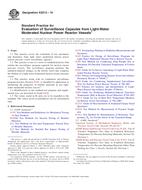Potrebujeme váš súhlas na využitie jednotlivých dát, aby sa vám okrem iného mohli ukazovať informácie týkajúce sa vašich záujmov. Súhlas udelíte kliknutím na tlačidlo „OK“.
ASTM E2006-10
Standard Guide for Benchmark Testing of Light Water Reactor Calculations
Automaticky preložený názov:
Štandardné Sprievodca pre Benchmark testovanie Light Water Reactor výpočty
NORMA vydaná dňa 1.10.2010
Informácie o norme:
Označenie normy: ASTM E2006-10
Poznámka: NEPLATNÁ
Dátum vydania normy: 1.10.2010
Kód tovaru: NS-43926
Počet strán: 7
Približná hmotnosť: 21 g (0.05 libier)
Krajina: Americká technická norma
Kategória: Technické normy ASTM
Kategórie - podobné normy:
Anotácia textu normy ASTM E2006-10 :
Keywords:
benchmark testing, calculational methods, least-square adjustment, neutron transport calculations, nuclear data, reactor pressure vessel, uncertainty estimates, Benchmark processing/testing, Least squares calculation, Neutron transport calculations, Nuclear applications/materials, Nuclear reactor vessels--light-water cooled, Uncertainty, ICS Number Code 27.120.10 (Reactor engineering)
Doplňujúce informácie
| Significance and Use | ||||||||||||||
|
This guide deals with the difficult problem of benchmarking neutron transport calculations carried out to determine fluences for plant specific reactor geometries. The calculations are necessary for fluence determination in locations important for material radiation damage estimation and which are not accessible to measurement. The most important application of such calculations is the estimation of fluence within the reactor vessel of operating power plants to provide accurate estimates of the irradiation embrittlement of the base and weld metal in the vessel. The benchmark procedure must not only prove that calculations give reasonable results but that their uncertainties are propagated with due regard to the sensitivities of the different input parameters used in the transport calculations. Benchmarking is achieved by building up data bases of benchmark experiments that have different influences on uncertainty propagation. For example, fission spectra are the fundamental data bases which control propagation of cross section uncertainties, while such physics-dosimetry experiments as vessel wall mockups, where measurements are made within a simulated reactor vessel wall, control error propagation associated with geometrical and methods approximations in the transport calculations. This guide describes general procedures for using neutron fields with known characteristics to corroborate the calculational methodology and nuclear data used to derive neutron field information from measurements of neutron sensor response. The bases for benchmark field referencing are usually irradiations performed in standard neutron fields with well-known energy spectra and intensities. There are, however, less well known neutron fields that have been designed to mockup special environments, such as pressure vessel mockups in which it is possible to make dosimetry measurements inside of the steel volume of the “vessel”. When such mockups are suitably characterized they are also referred to as benchmark fields. A benchmark is that against which other things are referenced, hence the terminology “to benchmark reference” or “benchmark referencing”. A variety of benchmark neutron fields, other than standard neutron fields, have been developed, or pressed into service, to improve the accuracy of neutron dosimetry measurement techniques. Some of these special benchmark experiments are discussed in this standard because they have identified needs for additional benchmarking or because they have been sufficiently documented to serve as benchmarks. One dedicated effort to provide benchmarks whose radiation environments closely resemble those found outside the core of an operating reactor was the Nuclear Regulatory Commission's Light Water Reactor Pressure Vessel Surveillance Dosimetry Improvement Program (LWR-PV-SDIP) (1) . This program promoted better monitoring of the radiation exposure of reactor vessels and, thereby, provided for better assessment of vessel end-of-life conditions. An objective of the LWR-PV-SDIP was to develop improved procedures for reactor surveillance and document them in a series of ASTM standards (see Matrix E706). The primary means chosen for validating LWR-PV-SDIP procedures was by benchmarking a series of experimental and analytical studies in a variety of fields (see Guide E2005). |
||||||||||||||
| 1. Scope | ||||||||||||||
|
1.1 This guide covers general approaches for benchmarking neutron transport calculations in light water reactor systems. A companion guide (Guide E2005) covers use of benchmark fields for testing neutron transport calculations and cross sections in well controlled environments. This guide covers experimental benchmarking of neutron fluence calculations (or calculations of other exposure parameters such as dpa) in more complex geometries relevant to reactor surveillance. Particular sections of the guide discuss: the use of well-characterized benchmark neutron fields to provide an indication of the accuracy of the calculational methods and nuclear data when applied to typical cases; and the use of plant specific measurements to indicate bias in individual plant calculations. Use of these two benchmark techniques will serve to limit plant-specific calculational uncertainty, and, when combined with analytical uncertainty estimates for the calculations, will provide uncertainty estimates for reactor fluences with a higher degree of confidence. 1.2 This standard does not purport to address all of the safety concerns, if any, associated with its use. It is the responsibility of the user of this standard to establish appropriate safety and health practices and determine the applicability of regulatory limitations prior to use. |
||||||||||||||
| 2. Referenced Documents | ||||||||||||||
|
Podobné normy:
Historická
15.2.2011
Historická
15.5.2011
Historická
1.1.2008
Historická
1.3.2010
Historická
1.6.2010
Historická
1.3.2010
Odporúčame:
Aktualizácia technických noriem
Chcete mať istotu, že používate len platné technické normy?
Ponúkame Vám riešenie, ktoré Vám zaistí mesačný prehľad o aktuálnosti noriem, ktoré používate.
Chcete vedieť viac informácií ? Pozrite sa na túto stránku.



 ASTM D7013/D7013M-11..
ASTM D7013/D7013M-11.. ASTM D7727-11e1
ASTM D7727-11e1 ASTM E1167-87(2008)..
ASTM E1167-87(2008).. ASTM E185-10
ASTM E185-10 ASTM E2005-10
ASTM E2005-10 ASTM E2215-10
ASTM E2215-10
 Cookies
Cookies
